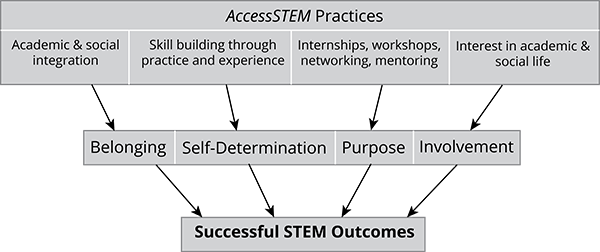Using STEM to Change the World
"Courage is being scared to death but saddling up anyway" - Shawn
STEM students and professionals are often motivated by the positive impact their work may have in the world. This includes people with disabilities in STEM The goal of AccessSTEM is to increase the number of individuals with disabilities completing postsecondary STEM degrees and entering the STEM workforce. AccessComputing has a similar goal, but focuses more narrowly on computing fields.
Project interventions for students with disabilities are consistent with the five conditions for nurturing healthy, successful children identified by America’s Promise—The Alliance for Youth: caring adults, safe places and constructive use of time, a healthy start and healthy development, effective education for developing marketable skills and lifelong learning, and opportunities to make a difference through helping others.
Through project activities, participants are encouraged to learn science (attraction), choose to keep learning mathematics and science (retention), graduate (persistence), and continue into STEM careers (attachment)—steps encouraged by the NSF Committee on Equal Opportunities in Science and Engineering.
Additionally, project leaders are guided by the results of an evaluation of research about NSF-funded programs conducted by SRI International in 2009 in which AccessSTEM was featured. SRI International identified important characteristics that contributed to successful outcomes of AccessSTEM were interventions that promote
- Belonging (both academic & social integration),
- Involvement (in academic & social life),
- Purpose (e.g., through internships, workshops, networking, mentoring), and
- Self-determination (skill building, practice).
Some students are excited about working on assistive technology, software, applications, health care, and other products designed to help individuals with disabilities. Others are more interested in using their STEM degree to work on myriad pressing issues such as climate change, national defense, social inequities, national infrastructure, and public policy.
In the following section of this book, students share their ideas about using STEM to change the world around them.
“Education is by far the most powerful weapon you can use to change the world.” - Nelson Mandela
